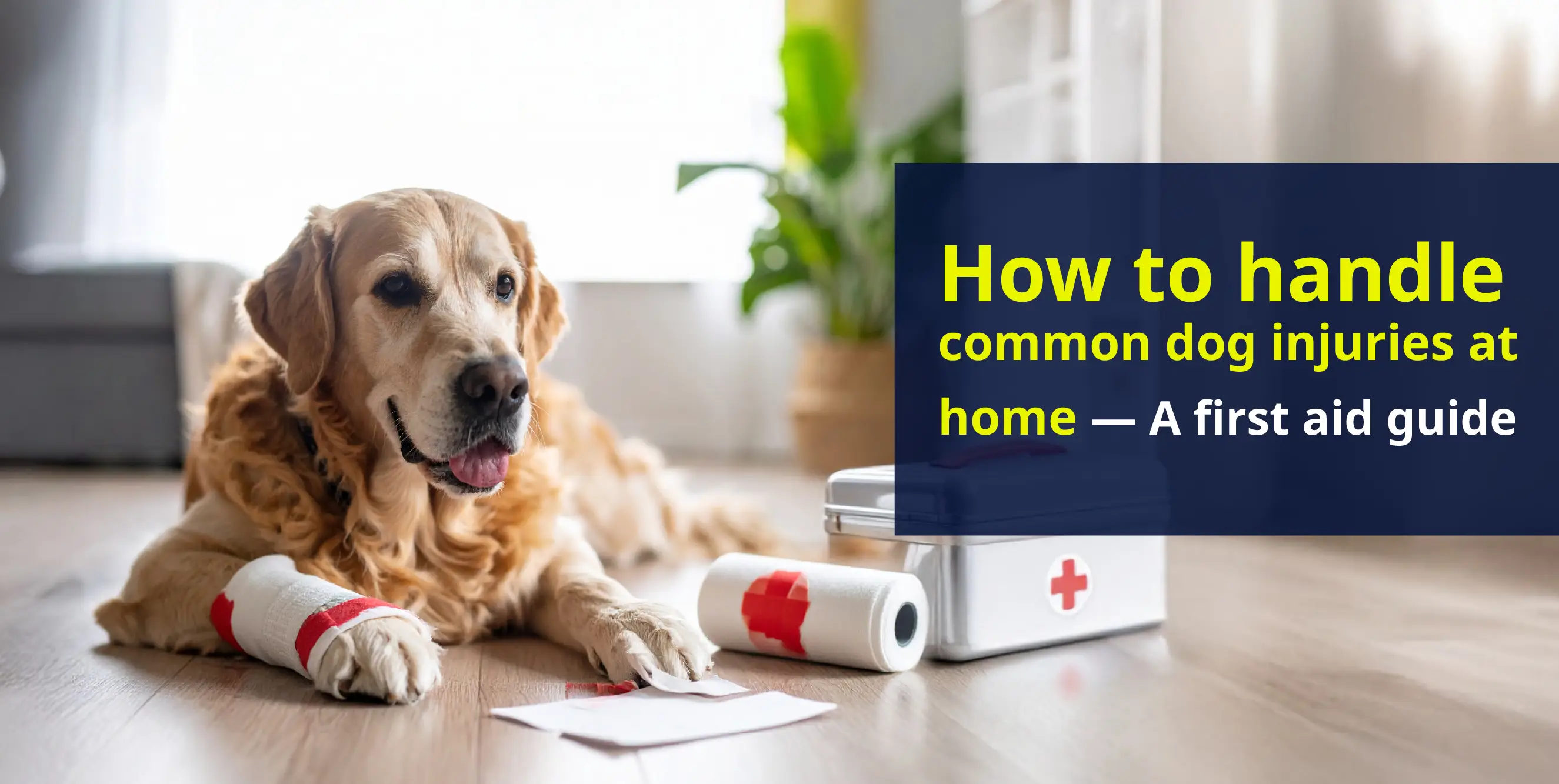Dog First Aid 101: How to treat common injuries at home
28-Jul-2025

Lucy Normile
When it comes to common dog injuries, having a basic knowledge of first aid can make such a difference. While it's important to remember that first aid is not a substitute for veterinary care, it can help stabilise your dog and provide comfort, and lessen stress for both them and you until they can see a vet.
1) What to do if your dog splits their tail
A split tail—sometimes called "happy tail syndrome" - is a common but frustrating injury for dog owners. It usually happens when an excited dog wags their tail so hard it hits walls, crates, or furniture, or runs through thick cover, causing the tip to split open. Because tails have lots of blood vessels and dogs love to wag, it can get messy fast and can be hard to heal.
Stay calm & keep your dog still: Movement = wagging = more bleeding. Try to keep your dog calm while you prepare your supplies.
Clean the wound: Use the saline solution from your Daktari kit to gently rinse the wound. This removes dirt and reduces infection risk. Avoid using hydrogen peroxide or alcohol, which can slow healing.
Stop the bleeding: Grab a gauze pad from the kit and apply gentle pressure to the tail tip for several minutes. If bleeding doesn’t stop within 10–15 minutes, consult your vet.
Bandage the tail: This can be tricky with wagging tails, but it’s essential. Cover the wound with sterile non-adhesive dressing. Wrap it gently with a padding bandage from the kit—tight enough to stay in place, but not so tight it cuts circulation, cover with the self-adhesive coflex bandage.
Check the tail once or twice a day: Change the bandage if it gets wet or dirty. Watch for swelling, foul smell, or pus—signs of infection
When to call the vet: The wound is deep or keeps reopening. Bleeding won’t stop. There’s clear pain, swelling, or signs of infection.
A Daktari First Aid Kit gives you everything you need for safe, at-home care in moments like this. But remember—if in doubt, your vet is just a call away.
Tail wags should be happy—not hazardous!
2) My dog has just cut itself while out in the woods. What should I do?
Cuts and scrapes are common injuries in dogs, and knowing how to provide initial cleaning and care can help prevent infection and promote healing. Here are the steps to follow –
Stay calm & keep your dog still: This will prevent more blood loss and also will allow you to see what you’re actually dealing with, a little blood goes a long way! Try to keep your dog calm while you prepare your supplies.
Clean the wound: Use the saline solution from your Daktari kit to gently rinse the wound. This removes dirt and reduces infection risk. Avoid using hydrogen peroxide or alcohol, which can slow healing.
Stop the bleeding: Grab a gauze pad from the kit and apply gentle pressure to the wound for several minutes. If bleeding doesn’t stop within 10–15 minutes, consult your vet.
Apply gentle pressure: If the wound is bleeding, apply gentle pressure with a clean cloth to help stop the bleeding.
Clean the wound: Use a mild antiseptic solution or saline solution to clean the wound. Avoid using hydrogen peroxide or alcohol, as they can damage healthy tissues.
Apply an antibiotic ointment: After cleaning the wound, apply a spray antibiotic ointment, if you deem it to be beneficial; this will help prevent infection.
Cover the wound: Cover the wound with sterile non-adhesive dressing. Wrap it gently with padding bandage from the kit—tight enough to stay in place, but not so tight it cuts circulation, cover with the self-adhesive coflex bandage.
Remember, if the cut or scrape is deep, won't stop bleeding, or shows signs of infection, it's important to seek veterinary care. First aid is meant to stabilise the injury temporarily, but a professional evaluation is necessary for proper treatment and healing.
3) What to do if your dog pulls a claw
Your dog’s claw might seem like a small part of their body, but if it gets pulled or torn, it can cause a lot of pain and distress. Whether it happened during a run at the park, play at home, or out working, here’s what you should do if your dog injures their claw –
Stay calm & keep your dog still: Dogs feed off our energy. If you panic, they’ll panic too. Gently restrain your dog to stop them from licking or worsening the injury. Offer comfort and keep them calm.
Check the injury: Look closely. Is the nail bent, cracked, or hanging by a thread? Is there bleeding? A torn claw is painful and can bleed a lot, but it’s rarely life-threatening.
Clean the area: If you have a Daktari first aid kit, now’s the time to use it. Flush the area with saline to rinse away dirt. Avoid using hydrogen peroxide, which can slow healing.
Stop the bleeding: Grab a gauze pad from the kit and apply gentle pressure to the wound for several minutes. If bleeding doesn’t stop within 10–15 minutes, consult your vet.
Protect the claw: Cover the wound with sterile non-adhesive dressing. Wrap it gently with padding bandage from the kit—tight enough to stay in place, but not so tight it cuts circulation, cover with the self-adhesive coflex bandage. Make sure it’s not too tight—you should be able to slip a finger under it.
Visit the vet: Sometimes the claw needs to be trimmed back or removed entirely, and your dog might need antibiotics or pain relief.
Injuries happen—be prepared.
The Daktari dog first aid kit has everything you need to handle minor injuries like this safely and confidently.
Explore Daktari Dog First Aid Kits at Rightgun.uk
About the author
Lucy Normile is a lifelong dog lover and the founder of DAKTARI, a brand born from her own experience of dealing with dog injuries on the go. Passionate about canine care and always ready for adventure, Lucy believes that being prepared can make all the difference for both you and your dog.
Must read:
